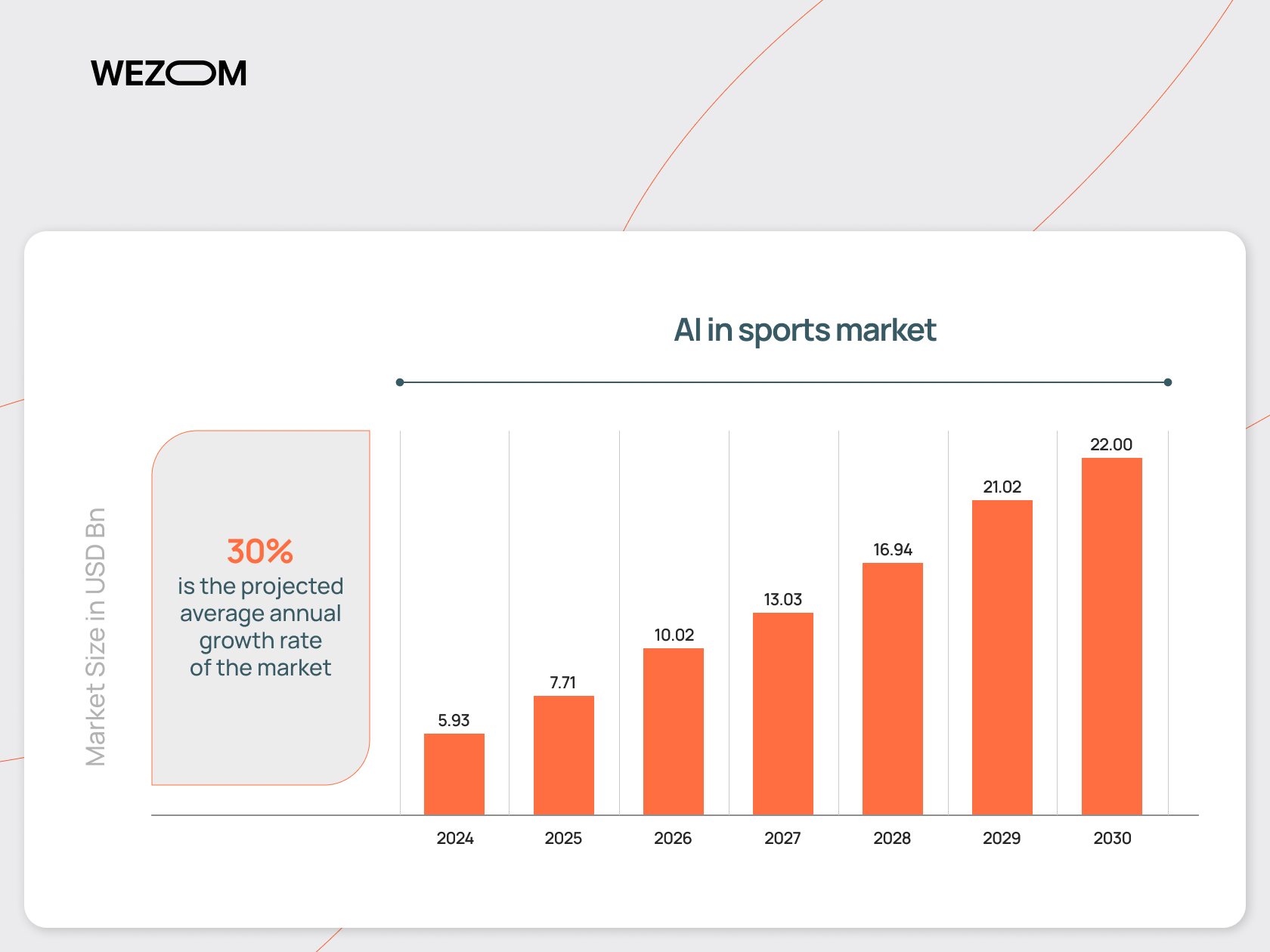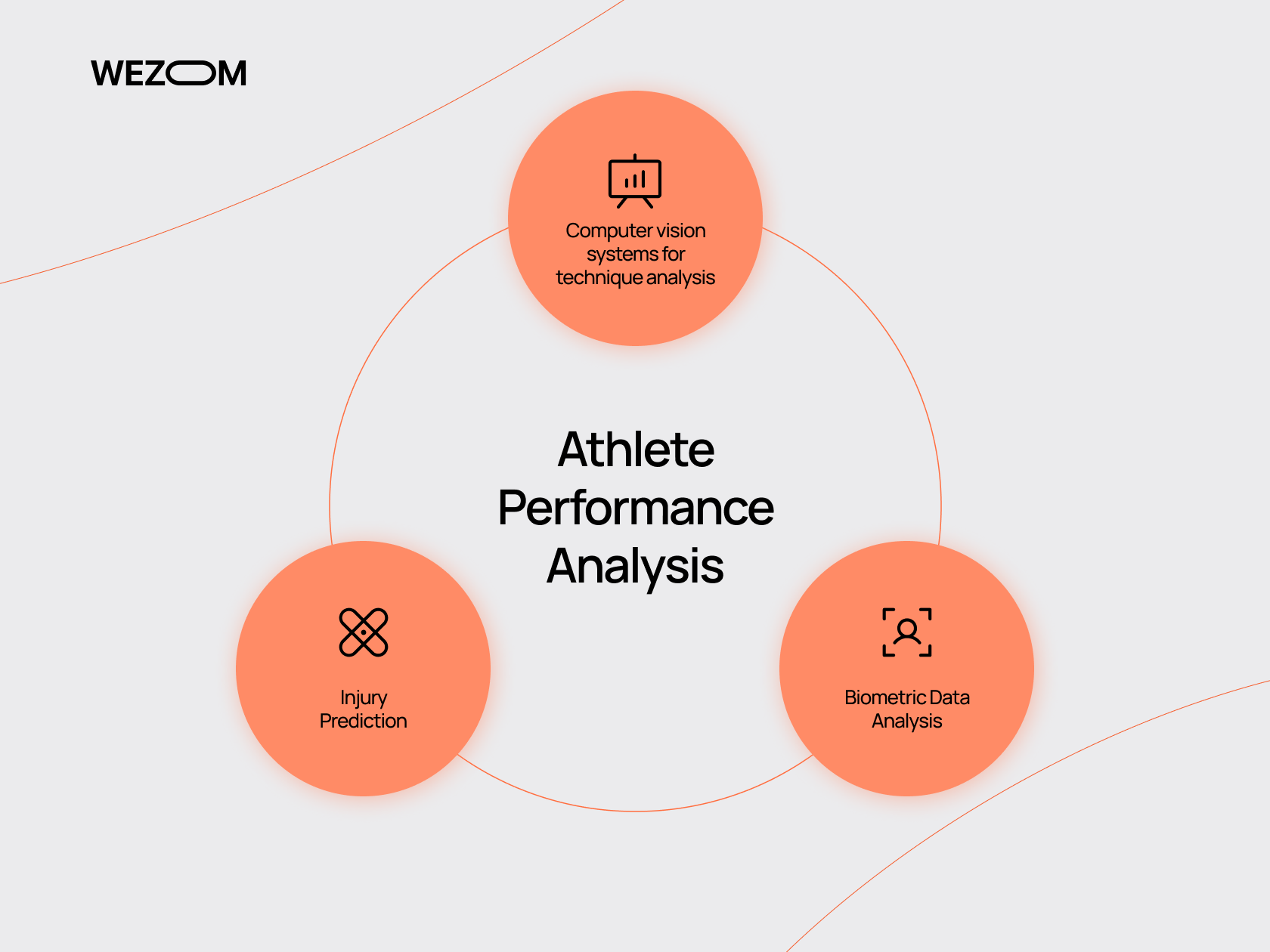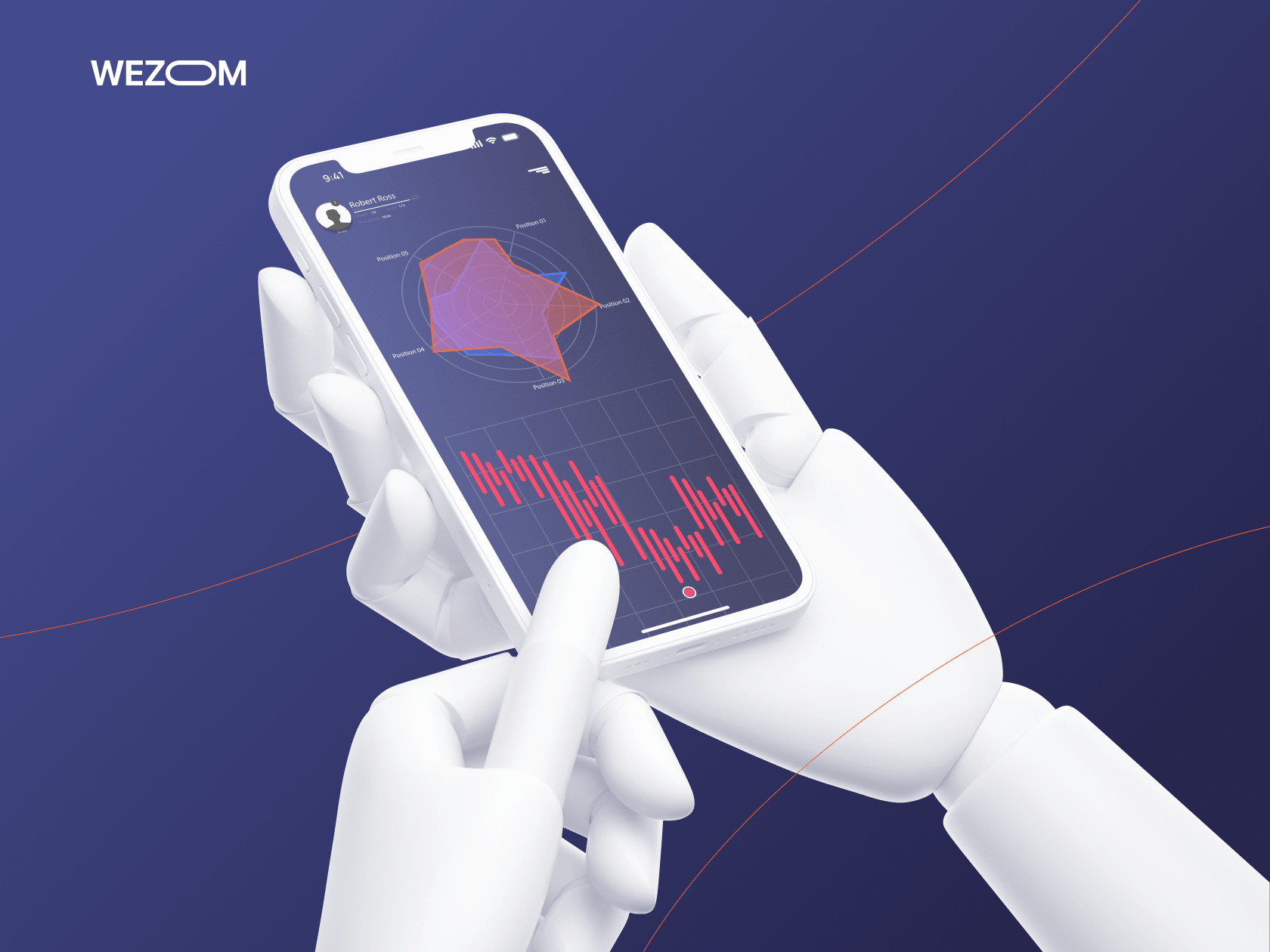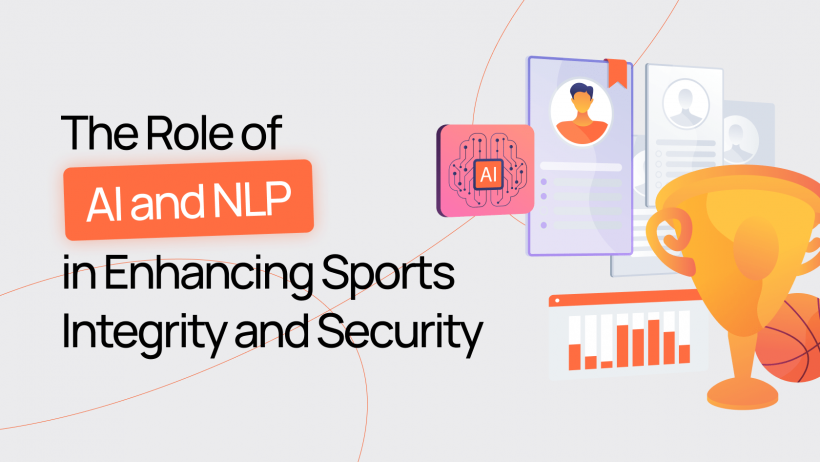Sports industries is the world where triumph and defeat go hand in hand.
The world of sports is one where the spirit of competition and fair play is celebrated as a near-sacred ideal. However, as with any sphere of human activity, sports are not without their darker side. Ambition, the thirst for fame, and vast sums of money often push some athletes and their entourages toward dishonesty.
Doping, match-fixing, and corruption—these dark blemishes occasionally come to light, casting a shadow over the entire world of sports. Despite ongoing efforts to combat these issues, they remain persistent challenges.
In this article, we will explore how artificial intelligence can become a powerful tool in the fight for fair sports, as well as discuss the challenges involved in its implementation.
Artificial intelligence in sport: key statistics
- In 2024, the global AI in sports market is valued at 5,93 billion.
- The market is projected to grow at an average annual rate of approximately 30%, reflecting the efforts of leagues like the NXL to adopt advanced technologies for enhancing competitiveness and fan engagement.
- By 2030, the AI-driven sports analytics market could reach 22 billion dollars.

The Emergence of AI and NLP in Sports
Artificial Intelligence (AI) and Natural Language Processing (NLP) have become integral to the sports industry since the early 2010s. This was when data analytics technologies started to be actively employed to enhance team performance and improve the spectator experience.
However, the first attempts to create statistical models for predicting match outcomes date back to the 1960s and 1970s. Of course! Throughout history, the desire to satisfy sports curiosity and profit from betting has driven people to seek tools for forecasting results. In the modern world, magical rituals and enchanted amulets have been replaced by sports analytics apps.
These began emerging as early as the 1980s, relying on statistical analysis of past sports competition results. By the 1990s, the first experiments with game recordings started, aiming to analyze athlete behavior on the field and improve team strategies.
The main challenges humanity has tried to address with artificial intelligence include:
- Enhancing sports integrity
- Detecting fraud and match fixing
- Real-time security solutions in sports events
- Enhancing player safety during training and games
How well have we succeeded? How are these technologies practically applied? Has the symbiosis of AI and sports, NLP, and machine learning truly occurred? Let's dive into these questions further.
Key Applications of AI and NLP in Sports
This is a vast topic, ranging from sports apps for fitness, which have become more personalized and effective thanks to AI, to the ability to prevent large-scale, multimillion-dollar scandals on a global level.
To make the discussion more structured, we will use a classification system that allows us to examine each aspect in detail and from multiple perspectives.
Athlete Performance Analysis
AI deepens understanding of fitness, technique, and injury risk for each athlete.
1. Computer vision systems for technique analysis
Technologies like Dartfish and Hudl are already leveraging computer vision to analyze training videos, particularly in the athletics industry. They allow for the analysis of athletes' movements, the identification of errors, and the optimization of performance.
Example: In tennis, an AI-based system evaluates the angle of the racket, the speed of movement, and the positioning of the legs, arms, and torso during a stroke. This helps refine technique and prevent mistakes.
2. Biometric Data Analysis
Wearable devices (smartwatches, sensors) collect data on heart rate, blood oxygen levels, and other biometric indicators. AI analyzes this data to monitor an athlete’s condition. Examples include Whoop and Catapult, which are commonly used by professional teams.
Example: In football, these devices track heart rate and fatigue levels, helping coaches adjust training loads accordingly.
3. Injury Prediction
Injury prediction is based on the analysis of historical data, current workloads, and biomechanics. Combined with biometric data and computer vision, it delivers nearly 100% accuracy, alerting coaches and athletes to potential risks (e.g., sports applications like IBM Watson Health).
Example: A system monitors changes in a runner’s gait, which may indicate an increased risk of knee injuries, allowing for early intervention.

Predicting Outcomes
AI in sport for predicting outcomes, tactical analysis, and strategy evaluation.
1. Match outcome prediction
Machine learning analyzes player statistics, weather conditions, match history, and numerous other factors to predict the outcomes of games.
Example: In baseball, AI systems predict which pitcher is most likely to perform well against a specific opponent. Opta and STATS Perform provide analytical forecasts for football clubs and fans in the sports industry.
2. Tactical analysis
AI in sports analyzes team movements on the field, helping coaches optimize tactics.
Example: In basketball, algorithms track how teams use defensive zones and suggest strategies to overcome them.
3. Strategy effectiveness evaluation
AI models various scenarios and assesses which approach will yield the best results.
Example: Football artificial intelligence analyzes whether the team should attack through the wings or use a more centralized strategy.
NLP in Sports Analytics and Safety
Natural language processing (NLP) enables the analysis of textual and audio information related to sports.
NLP can predict sentiments in sports reports and comments, providing insights into public opinion about a team or athlete. It can also help prevent harassment or cyberbullying.
For example, analyzing comments on sports forums can identify growing criticism of a specific player or team. This, in turn, can affect their reputation, ticket sales for matches, fan behavior in stadiums, and more. NLP can also detect threats or organized campaigns against athletes.
Example: During major tournaments, NLP algorithms monitor platforms such as Twitter and Facebook to detect aggressive sentiments or plans to organize disturbances.
Furthermore, NLP automatically generates text reports after matches, summarizing key events and statistics. Systems like Stats Perform create news about sports events based on real-time data. Additionally, algorithms track mentions of injuries, player transfers, and tactical changes, providing a complete picture of events on demand, even without the involvement of “live” journalists.
The greatest benefit, however, comes from analyzing internal communications. This can help identify signs of corruption or match-fixing through employee messages.
Decision Support Systems
AI sports simulation programs and analytics help coaches and managers make more accurate decisions. For example, they optimize lineups based on data about player fitness, compatibility on the field, and tactical importance.
Example: In hockey, the system predicts which goalkeeper will perform better against a specific opponent based on previous matchups.
Sports artificial intelligence offers personalized training plans, taking into account athletes' goals, biometrics, and current fitness levels. Additionally, these systems analyze opponents' playing styles to develop effective counter-strategies.
Fan Activity Analysis
Sports data analysis tools allow sports organizations to better understand their fans and improve their experience. They assess how fans perceive matches, players, or events.
Sport AI predicts the number of spectators at matches based on weather, days of the week, and team popularity.
Example: In baseball, MLB uses AI to evaluate which games will attract the most viewers.
Based on fan interest data, artificial intelligence in sports offers personalized recommendations for content, products, and services. For example, merchandise from a favorite team, exclusive signed items, highlight reels, etc.
Fraud detection and match-fixing detection
Fraud, including match-fixing, undermines the integrity of sports. Sports AI actively combats this phenomenon by:
- detecting suspicious spikes in activity on betting platforms;
- comparing athletes' behavior with typical scenarios, identifying deviations;
- comparing current results with past statistics to find discrepancies.
Example: In football, AI can detect illogical actions by defenders who allow goals and compare them with suspicious betting patterns.
Challenges of Implementing Artificial Intelligence and Natural Language Processing Systems
One of the first challenges that comes to mind is, of course, ethical concerns. Let's consider a situation: a program analyzes the opponent's serves before an important tennis match. It then provides the athlete with recommendations on how to position their hand to return the shots, creates a training plan, and includes exercises for more effective counterattacks. In this case, is there a risk that AI impact on sports strategies turns athletes into mere puppets, performing blind actions? This is referred to as "dehumanization." The diminishing roles of coaches, referees, and managers could lead to higher unemployment in the sector. Fans often complain that the heavy use of machine learning for sports takes away the emotional character of the game.
Another issue is that one of the competitors might have more extensive financial resources. AI technologies can be expensive, which could create unequal conditions for athletes from different social classes. Wealthy teams will gain access to more advanced technologies, potentially giving them an unfair advantage. The ethical questions surrounding AI implementation require a balance between technological progress and preserving human values.
The problem of algorithmic bias
AI can absorb biases from the data it is trained on. For example, in American football, analysis algorithms may underestimate the talents of players from smaller colleges if they are not included in historical data. This can lead to an unfair distribution of opportunities.
Privacy violations
The collection of data, including biometric indicators, raises concerns about invasion of privacy. Additionally, AI is still vulnerable. There are possibilities where malicious actors could use it to hack video surveillance systems or create fake video recordings.
Example: In 2021, football players opposed the use of GPS sensors that track their location and physiological parameters, fearing information leaks and its potential use against them (for example, during transfers).
Transparency and trust issues
AI algorithms often operate as a "black box": their decisions are difficult to explain.
If AI mistakenly predicts a player’s low performance level, it can negatively impact their career. Athletes may be discriminated against due to inexplicable recommendations.
The widespread implementation of AI in sports could change the very nature of the sport, making it more technological and less human. And, as we understand, we still don’t have clear principles or legislative norms that could resolve this issue. In fact, these are equally important challenges of implementation:
- Adapting existing infrastructure (which can be expensive and labor-intensive);
- Implementing strict control over data quality to avoid erroneous calculations;
- Developing a legislative framework that will regulate all aspects and be satisfactory to the global community;
- Allocating responsibilities. For example, who is responsible for AI errors, such as when an algorithm incorrectly predicts an injury or determines doping?
Equally important is overcoming organizational challenges. Athletes and coaches may fear losing their jobs or influence due to human decisions being replaced by algorithms.
However, there are already many examples where these challenges have been mitigated by the benefits of using AI, and the positive aspects have outweighed the negatives. One such example is described below.
Case study: AI and NLP in Enhancing Sports Integrity
Task: We were approached by Beter, a leader in innovations for the sports industry. Their task was complex and ambitious: to develop a platform that would help sports club integration managers assess the loyalty of athletes and coaches, preventing potential risks for the club. This solution was meant to be a powerful tool for managing security and trust.
Solution: We created a SaaS solution that combines the power of artificial intelligence (AI) and the convenience of a centralized dashboard. The platform uses an AI chatbot based on Llama 3.2, which communicates with players via Telegram, Instagram, and LinkedIn. The bot’s goal is to analyze athletes' responses and identify potential risks such as unethical behavior, declining loyalty, or conflicts of interest.

Key Features:
1. Integration with Social Media: The platform supports automatic communication with popular messaging apps, providing an easy and convenient channel for interaction between the club and athletes.
2. AI Chatbot: Customizable scenarios allow integration managers to set the tone of conversations, analyze emotions, and adapt dialogues in real-time. For younger players, the bot uses informal language, while for experienced professionals, a more formal tone is applied.
3. Emotion and Behavior Analysis: The AI detects changes in the athlete's mood, such as a shift from trust to caution, and suggests actions for the manager to take.
4. Report Generation: After each conversation, the platform automatically generates a detailed report outlining key conversation points, risk assessments, and recommendations.
Result:
We helped Beter develop an effective tool for managing risks and loyalty. This solution is already being used by several sports clubs, assisting managers to:
- Identify potential conflicts before they arise.
- Save time on athlete assessments.
- Make the communication process transparent and standardized.
Conclusion
If you want to implement advanced AI and NLP solutions and order sports app development, you're on the right track.
For example, we can help you enhance security at your club, automate loyalty management, and integrate AI into everyday tasks. Or we can focus on the technological aspect of your idea, whether it's machine learning in athletics, smart sports technology or artificial intelligence startups in sports.
The Wezom team will help develop a tailored solution for your business.
In a world where speed and flexibility are key factors for success, we offer not just software products, but entire ecosystems that make your work simpler, faster, and more efficient. Our SaaS solutions are powerful tools for transformation.
We leverage the latest advancements in AI, machine learning, and data processing to ensure that your solutions are not only functional but also intelligent. From data analysis to process automation.
Ready to take the next step? Contact us to discuss how we can help you achieve your goals.

